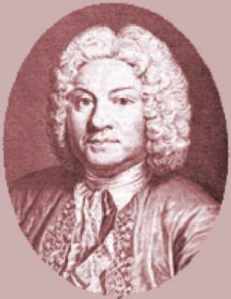Opening Voluntary: “Elevation” – Tierce en Taille – François Couperin (1668-1733)
Final Voluntary: “Deo Gratias” – Petit Plein Jeu – François Couperin (1668-1733)
Both of today’s incidental organ works are compositions of the French Classical Period master composer, François Couperin (1668-1733) known often by his title of “Couperin Le Grand” or “the great Couperin” in order to distinguish him from other composers and organists of this French musical dynasty. Couperin was born in Paris on 10th November, 1688 and was taught initially by his father Charles until his death and then later by Jacques Thomelin, who was organist to Louis XIV. At the age of only 17 years, Couperin followed his father as organist of the great Paris church of St. Gervais. He succeeded his teacher, Thomelin, in 1695 as the titular organist of the Chapelle Royale at the palace of Versailles and was styled “organiste du Roi” (organist to the King) by appointment of Louis XIV.
Although Couperin composed many pieces for voices, harpsichord and various instruments, only one of his organ compositions survives – his two-part masterwork of the organ masses, respectively titled “for the Parishes” and “for the Convents.” These works were composed by Couperin when he was quite young, and he was granted a license from Louis XIV to publish them in about 1690, when only 21 years of age. Both works are in a style, popular at the time, known as “alternatim” organ masses in which lines of plainchants of the mass were sung in “alternation” with solo organ music. There were, as well, pieces such as “offertories” and “elevations” set as musical accompaniments to their respective liturgical actions.
Both our opening and closing voluntaries are from the “Mass for the Convents” intended for use in convents and abbeys. Although the “Mass for the Parishes” is clearly based on the Gregorian plainchant mass, Cunctipotens genitor Deus, the mass for the Convents is based on no recognizable plainchant melody. Speculatively, it is believed that it was written in this manner as each religious institution typically maintained its own, non-standard collection of chant music.
Following typical French practice, each organ piece is subtitled with a notation that indicates the intended registration (selection of stops) to be used (and which we must, understandably, adapt for our non-French style organ). These “standardized” registrations were also typically associated with a particular style or texture of musical composition such that the “Tierce on Taille” for example, has the melody in a clear solo registration in the tenor line and is typically played rather slowly and is also greatly ornamented and embellished. Such pieces made extensive use of the French practice of “notes inégales” in which the performer varies the written note lengths/rhythms according to musical taste and established convention to create an individualistic and more expressive musical performance. The closing voluntary is designated a “Petit Plein Jeu,” essentially a small, “full organ” registration.

